Apache CXF 分布式OSGi部署HelloWorld
摘要
要配置Apache CXF OSGi的部署其实比较简单,但是我们一般都会在网上找资料,会遇到怎么也发现不了服务的情况,让人都很郁闷。
有了这次的经历,我要看官方的文档,以防上当。
一、环境准备
首先下载Apache CXF 的包,下载地址:http://cxf.apache.org/dosgi-releases.html
我们下载下面这两个就可以了,我们这次会用到cxf-dosgi-ri-singlebundle-distribution
Multi-bundle distribution (zip)
cxf-dosgi-ri-multibundle-distribution-1.3.1-dir.zip
Single-bundle distribution
cxf-dosgi-ri-singlebundle-distribution-1.3.1.jar
目前需要3个bundle
注意版本号
导入cxf-dosgi-ri-singlebundle-distribution-1.3.1.jar 包,在Eclipse中菜单:File->import,选择如下图所示
选择文件所在的路径
我们会在Package Explorer视图中看到
好了,我们的开发环境就配置好了。
二、创建演示程序-生产服务
创建HelloWorld演示程序
Eclipse->File->new->project-
我们就写一个helloworld的接口
代码如下:
public interface HelloWorldService { String sayHello(); }接下来我们用同样的方法来,做一个HelloworldService的实现工程
Eclipse->File->new->project
我们来写一个实现类如下,首先添加对接口的依赖
实现类如下:
public class HelloWorldServiceImpl implements HelloWorldService { @Override public String sayHello() { System.out.println("HelloWorld"); return (new Date()).toString(); } }
现在实现类有了,我们现在要注册成web服务,打开实现工程中的Activator类,注册服务代码如下:
public class Activator implements BundleActivator { @SuppressWarnings("rawtypes") private ServiceRegistration registration; private static BundleContext context; static BundleContext getContext() { return context; } @Override public void start(BundleContext bundleContext) throws Exception { Activator.context = bundleContext; //设置服务的属性 Dictionary<String, String> props = new Hashtable<String, String>(); props.put("service.exported.interfaces","*"); props.put("service.exported.intents","SOAP"); props.put("service.exported.configs","org.apache.cxf.ws"); props.put("org.apache.cxf.ws.address","http://localhost:9000/hello_world"); //注册服务 registration = Activator.context.registerService(HelloWorldService.class.getName(), new HelloWorldServiceImpl(), props); } @Override public void stop(BundleContext bundleContext) throws Exception { Activator.context = null; registration.unregister(); } }
好了,我们的服务已经注册成功了,我们看看在浏览器中是什么样子的,
Eclipse-Run->Run configuration,配置结果如下图所示:
点击run后我们可以看到如下日志:
这就说明了我的web服务已经注册成功了,好了,我们在浏览器中看一下结果,在浏览器中输入:http://localhost:9000/hello_world?wsdl,就可以看到如下结果
接下来我们会消费服务
三、消费服务
我们建一个插件工程,命名为:HelloWorldClient,创建好以后如下:
我们要使用服务就要先引用依赖组件,如下图所示
我们还要配置一下服务的发现,在工程下建立OSGI-INF文件夹,里面新建一个remote-service文件夹,在remote-service新建一个remote-services.xml,该文件内容如下:
<?xml version="1.0" encoding="UTF-8"?> <service-descriptions xmlns="http://www.osgi.org/xmlns/sd/v1.0.0"> <!--远程服务描述--> <service-description> <!--定义远程服务映射到本地的服务的接口 --> <provide interface="helloworldservice.HelloWorldService" /> <!-- 远程服务的接口 --> <property name="service.exported.interfaces">*</property> <!-- 远程服务的形式 --> <property name="service.exported.intents">SOAP</property> <!-- 服务的类型--> <property name="service.exported.configs">org.apache.cxf.ws</property> <!-- 服务的地址--> <property name="org.apache.cxf.ws.address">http://localhost:9000/hello_world</property> </service-description> </service-descriptions>
和我们在实现类里面注册服务的代码一样
我们来看一下HelloWorldClient的Activator类的内容,主要的内容就是获取服务,然后调用服务,很简单。
public class Activator implements BundleActivator { @SuppressWarnings("rawtypes") private ServiceTracker tracker; private static BundleContext context; static BundleContext getContext() { return context; } /* * (non-Javadoc) * @see org.osgi.framework.BundleActivator#start(org.osgi.framework.BundleContext) */ @SuppressWarnings({ "unchecked", "rawtypes" }) public void start(BundleContext bundleContext) throws Exception { Activator.context = bundleContext; //创建ServiceTracker,捕获HelloWorldService添加到OSGi框架的事件 tracker = new ServiceTracker(Activator.context, HelloWorldService.class.getName(), null) { @Override public Object addingService(ServiceReference reference) { Object result = super.addingService(reference); //获取服务 HelloWorldService helloWorldService = (HelloWorldService)Activator.context.getService(reference); //使用服务 System.out.println("call say hello at " + helloWorldService.sayHello()); return result; } }; tracker.open(); } /* * (non-Javadoc) * @see org.osgi.framework.BundleActivator#stop(org.osgi.framework.BundleContext) */ public void stop(BundleContext bundleContext) throws Exception { Activator.context = null; System.out.println("hello world client close"); tracker.close(); } }
好了,我们的消费者就创建好了,来看一下运行效果吧
先进行运行 配置,如下图所示
我们在上图中可以看到结果
好了,我们的演示已经结束了,看起来还是比较简单的,但是在做的过程中还是遇到一些问题,比如使用了老的注册服务代码如下:
props.put("osgi.remote.interfaces", "*");
props.put("osgi.remote.configuration.type", "pojo");
props.put("osgi.remote.configuration.pojo.address", "http://localhost:9000/hello_world");
使用这个代码是注册服务不成功的,请大家注意!
源码下载:下载





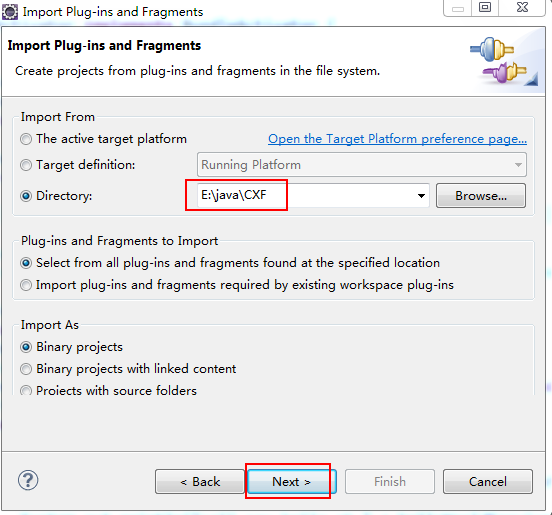
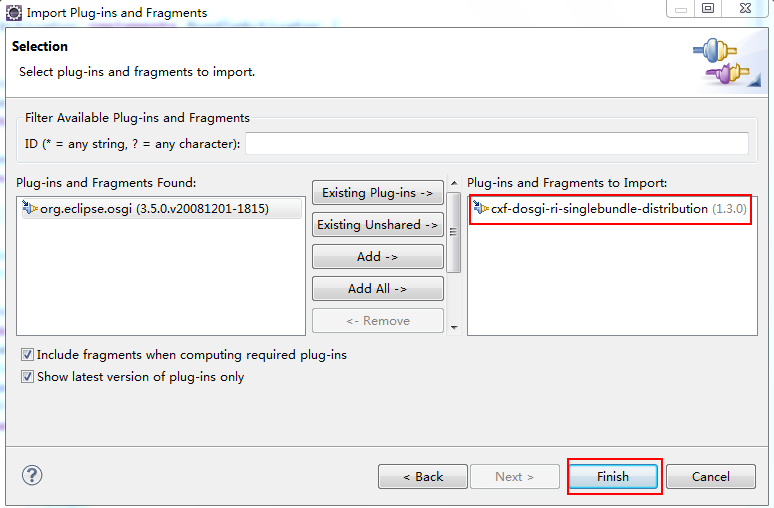

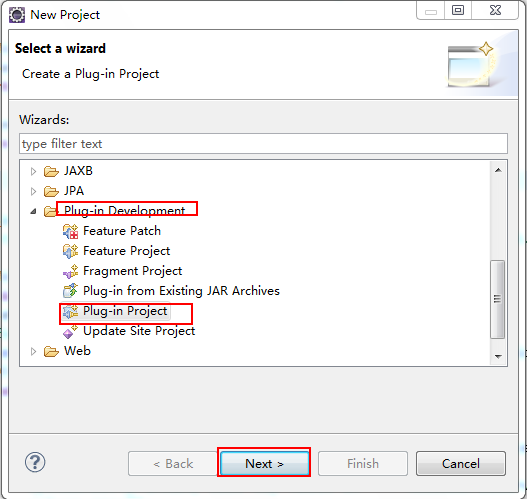
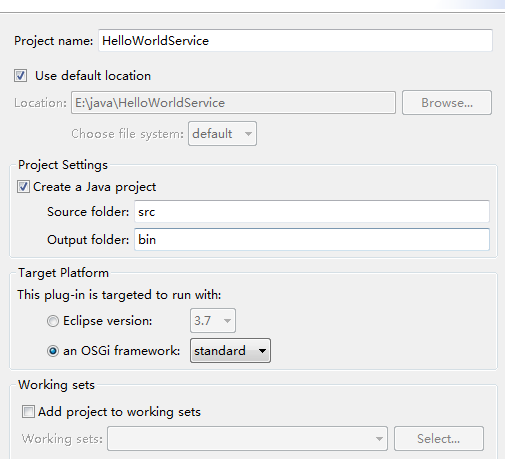
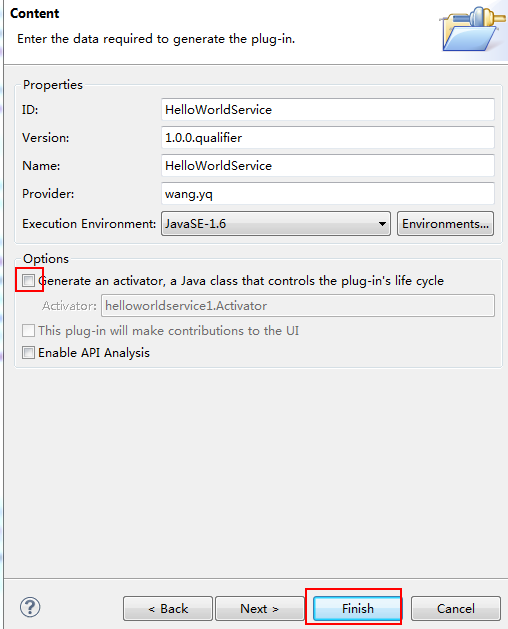

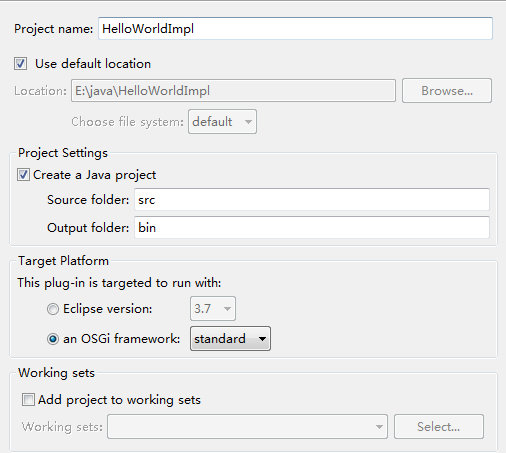
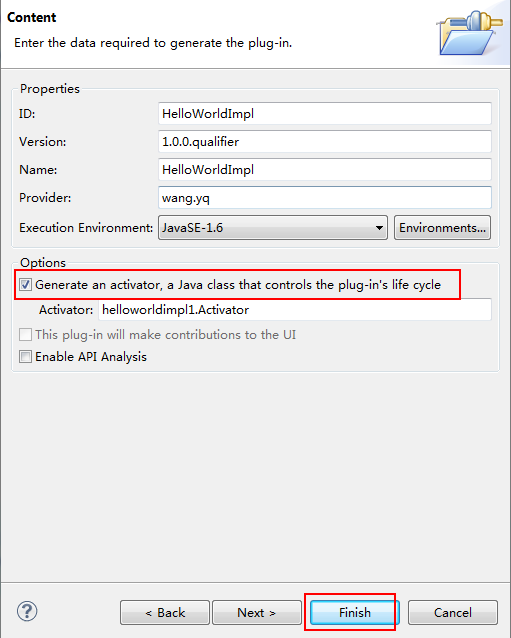
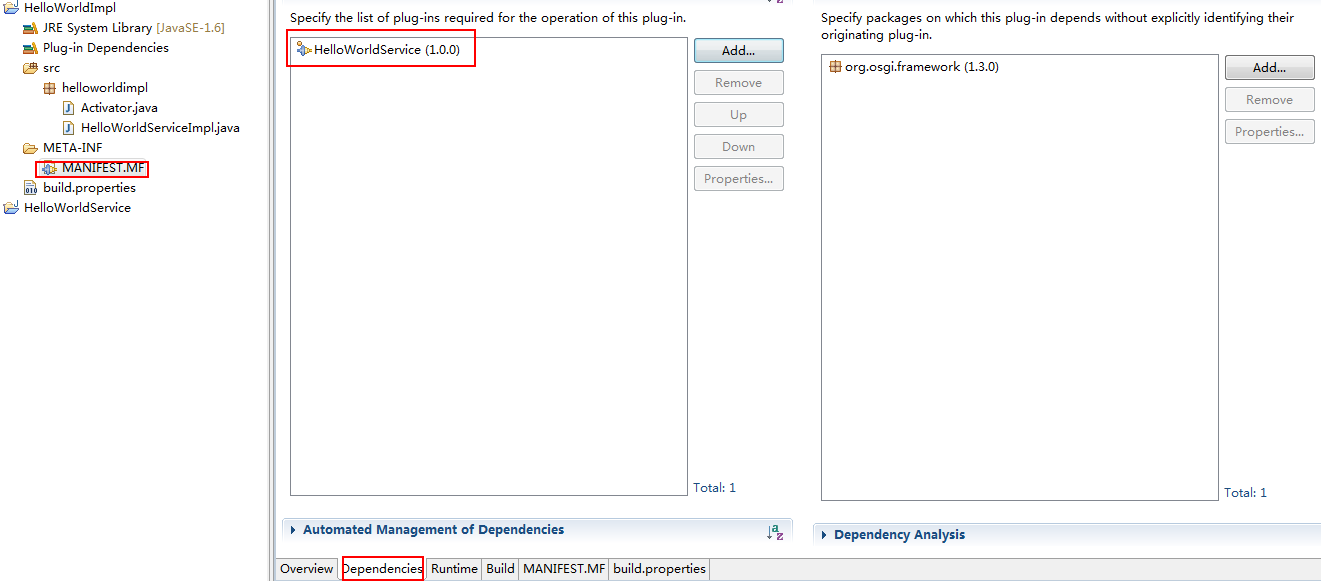
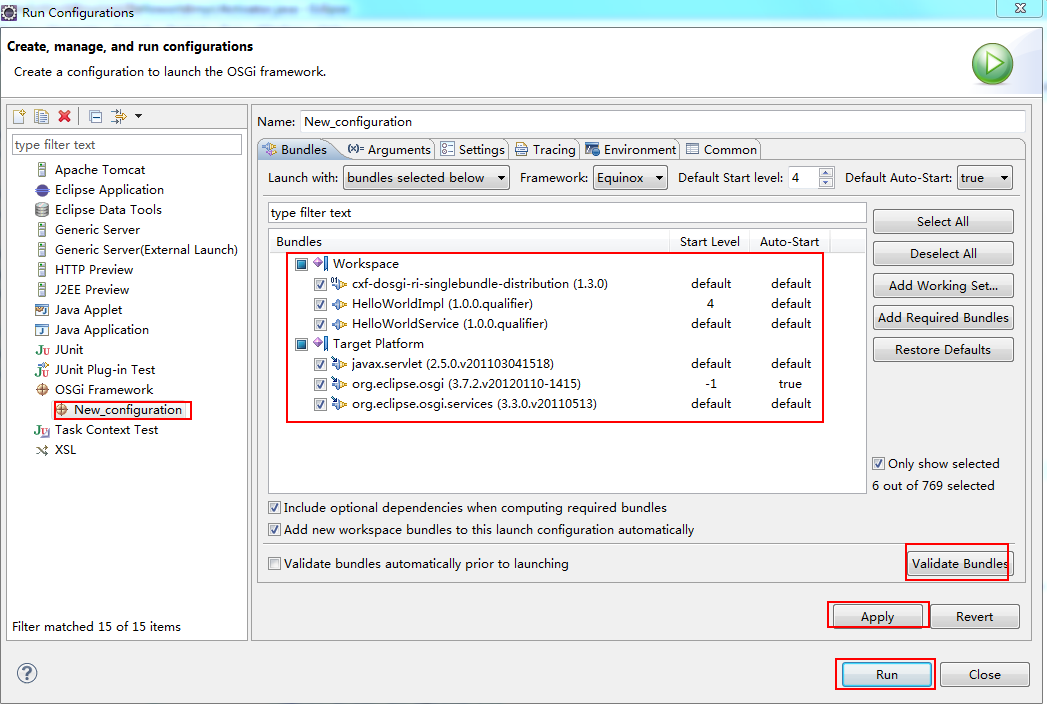
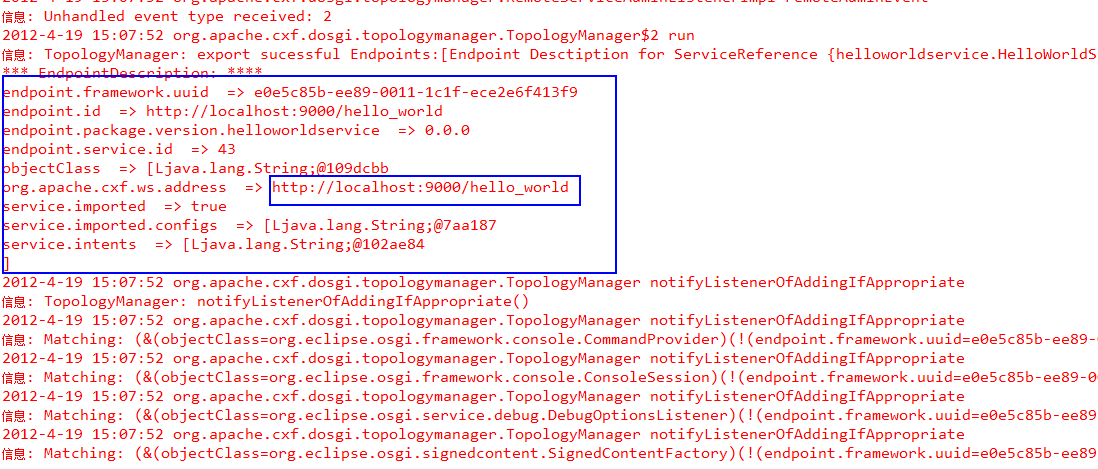



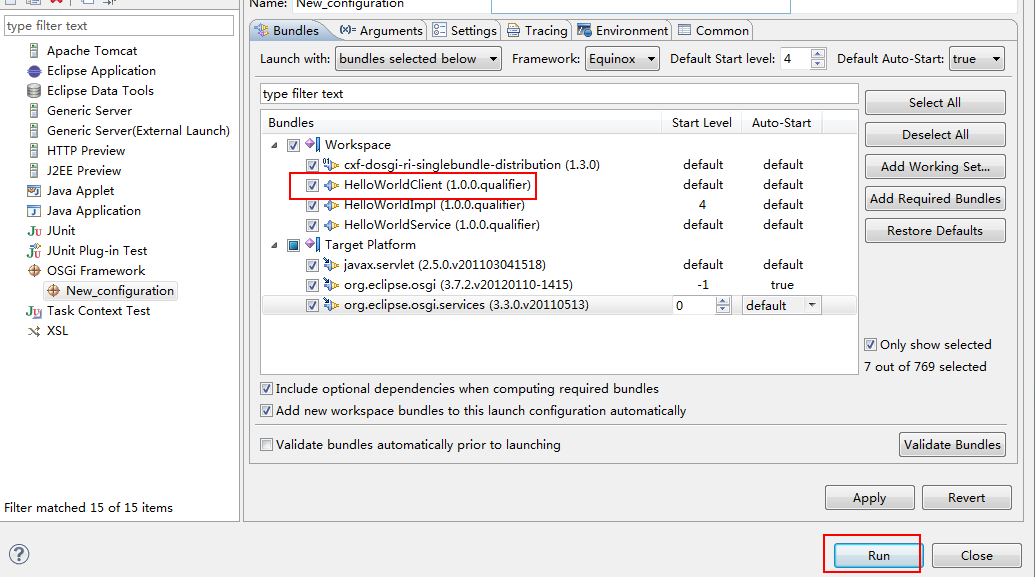


 浙公网安备 33010602011771号
浙公网安备 33010602011771号